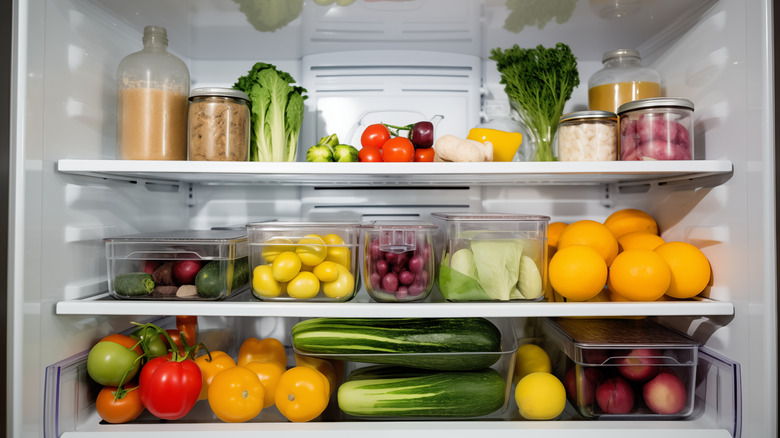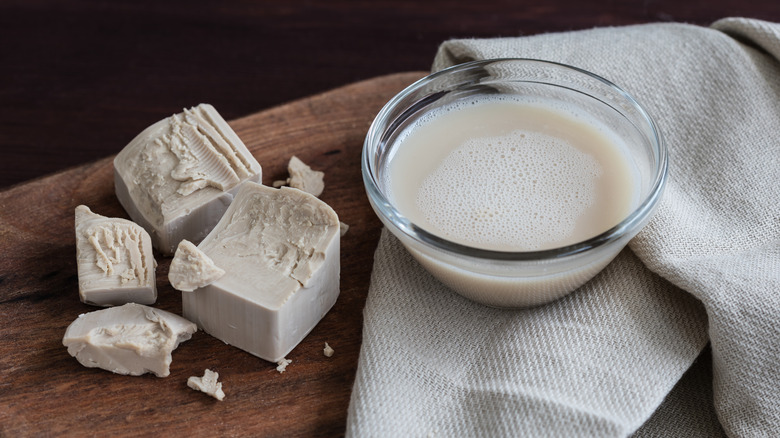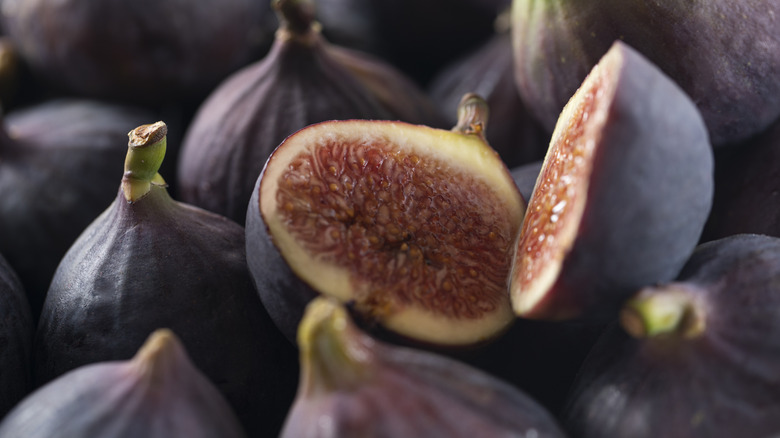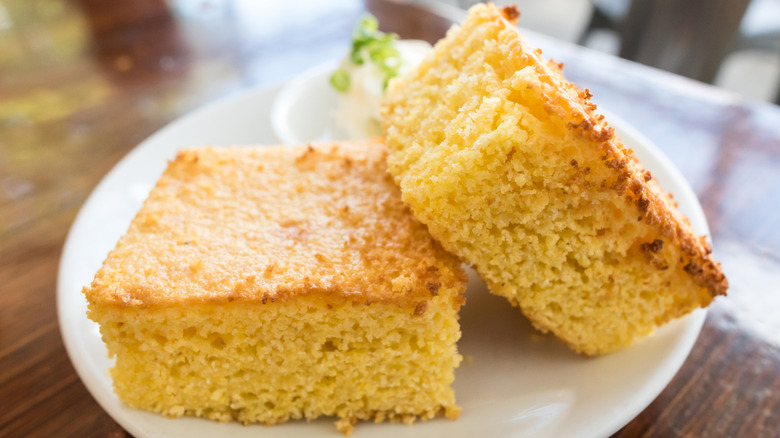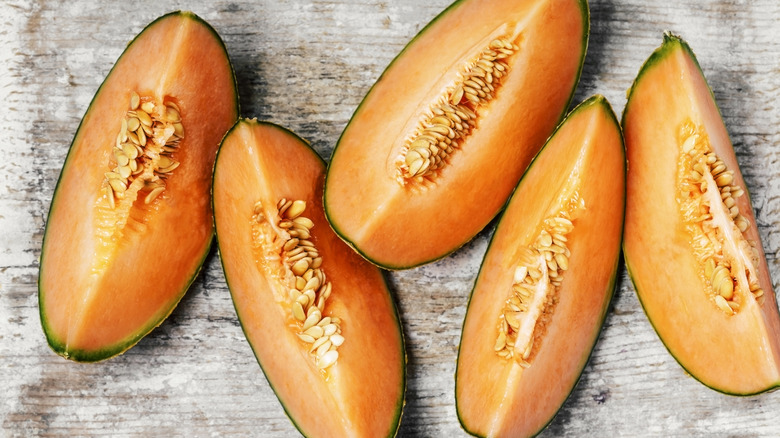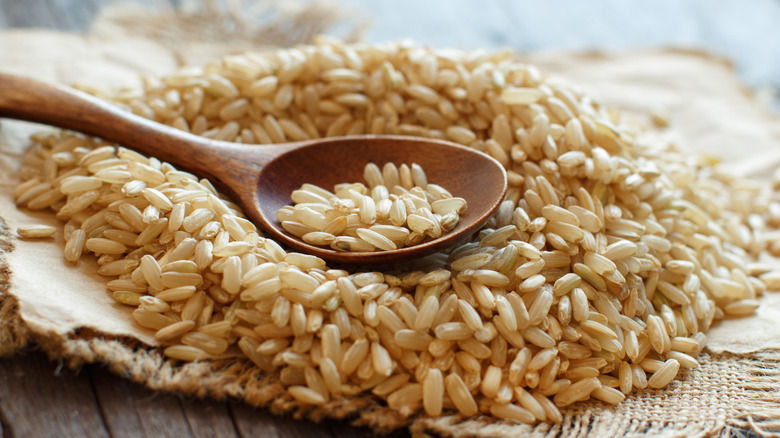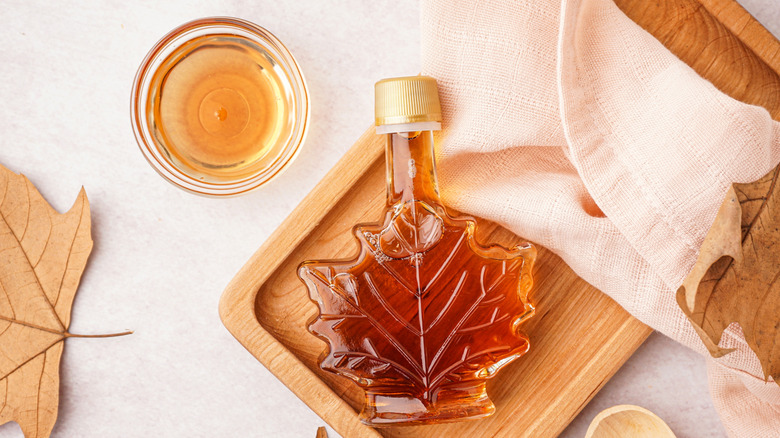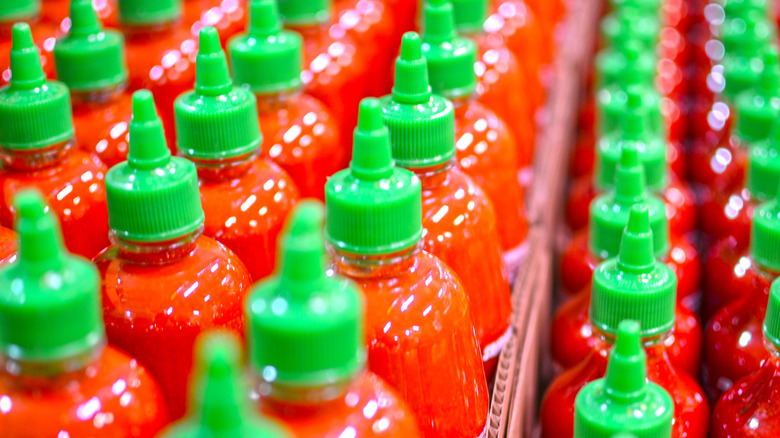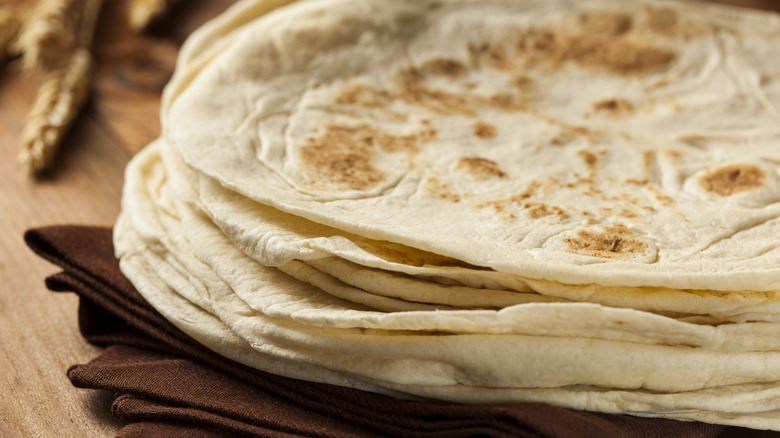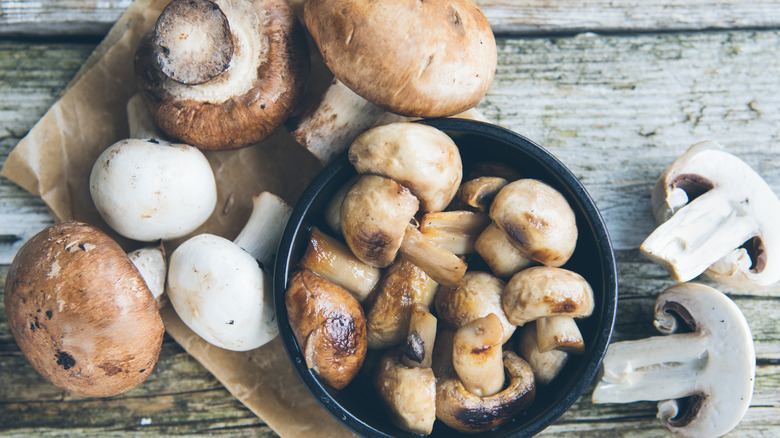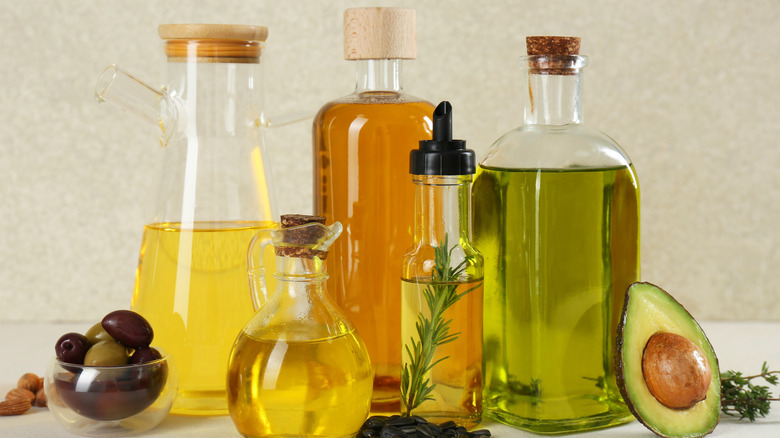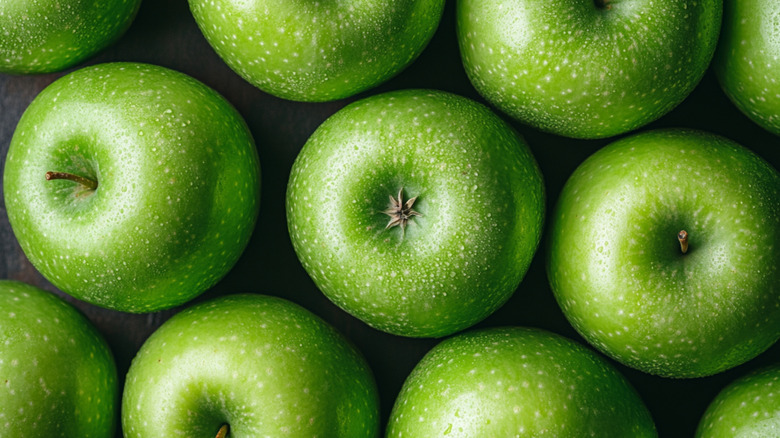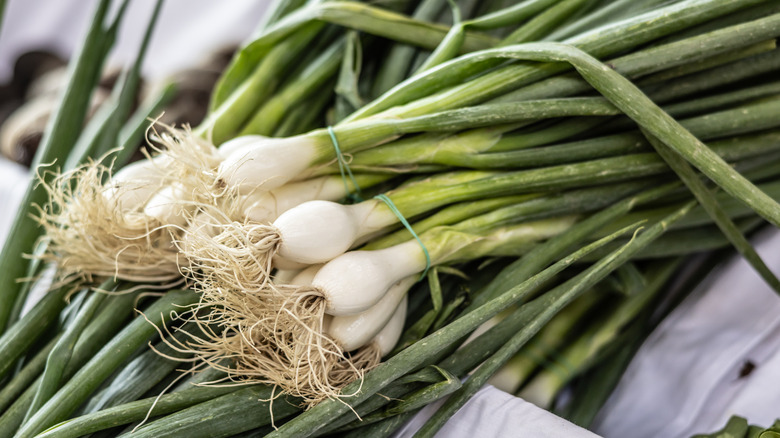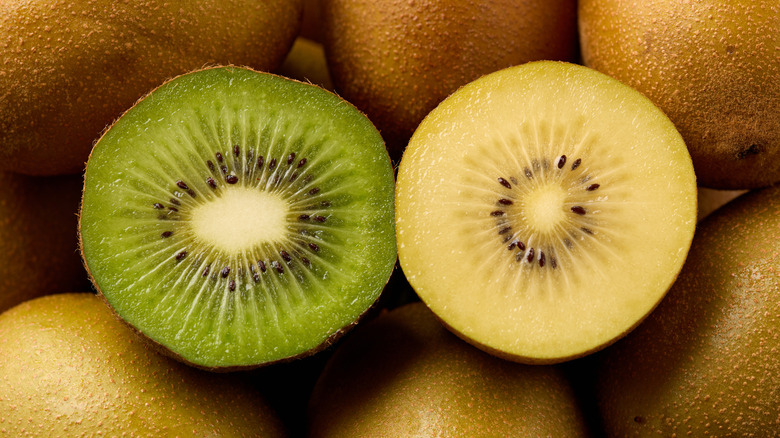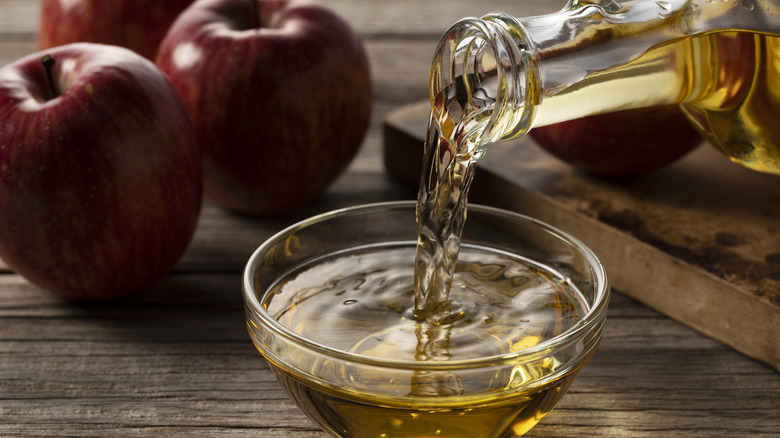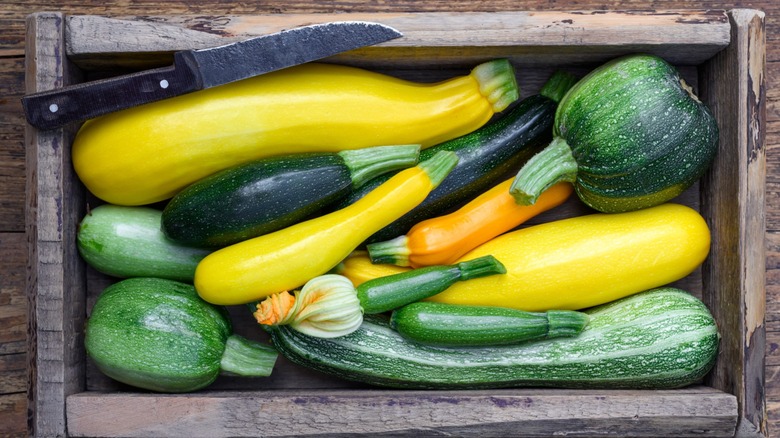18 Foods You Might Not Have Known Should Be Refrigerated
Almost every home has one: An almost-silent workhorse at the heart of the kitchen, keeping food fresh and drinks chilled until the moment we want them. The refrigerator as we know it has only been common in homes since the 1920s and 1930s. These days, of course, we can barely get by without them. Refrigerators are so widespread now that there are lots of rules about how best to stock them, keep them tidy, and even fridgescaping — a relatively new phenomenon where you artfully decorate the inside using produce, containers, and more.
Whether you choose to stack your carrots in the crisper drawer or in a pottery container is up to you. The more pressing question is: Which foods really need to be in the fridge? It's not quite the no brainer it appears. Why does some produce need to be separated from others? What happens to yeast if it isn't kept cool, and what's the deal with infused vinegar? Here are 18 foods you never knew should be refrigerated.
Yeast
The last thing we want is anything living in our fridges, but yeast is a notable exception. This microscopic organism is the key component of beer, wine, and breadmaking, and comes in two forms: Dried and fresh. The latter is literally alive and must be stored in the refrigerator to keep it that way.
You should be able to keep any fresh yeast in the fridge for around a fortnight. If you want to freeze it, crumble it up first before popping it in a plastic container – but don't ever be tempted to freeze it once it's been activated, because that will kill it.
It's a different story for dry or granular yeast, which can stay active for up to two years as long as it stays unopened. Once you've cracked that container, make sure to store it in the fridge or freezer, where it will keep for four to six months, respectively.
Figs
These fruits are available from early summer to early fall, so it's tempting to buy lots of figs at a time and gorge on their delicious sweetness. But you can enjoy them for a little longer if you know how. While figs don't ripen after they are picked, if left at room temperature for too long, they can go mushy. Popping them in your fridge will extend their lifespan by up to a week.
Don't be tempted to throw your figs on any old fridge shelf and walk away, as they need a little more TLC. Find a shallow, breathable tray and lay the fruit on it, using paper towels if need be to ensure they don't touch. Then, place the container in the crisper or the coldest part of the fridge. Be aware figs are sensitive to ethylene, so unless you're trying to ripen them a little more, keep them away from fruit such as apples or bananas which emit this gas.
Cornbread
Few things are as appetizing as a batch of cornbread fresh from the oven. As well as being delicious and flexible with a sweet-savory flavor that goes with just about anything, it's also quite a hardy food and will tolerate being left at room temperature for up to three days. After that time, it's best to refrigerate your cornbread to ensure it stays edible.
The best way to do it is to store bigger pieces, if possible, so that you maximize the surface area. Also, make sure all the pieces are completely cool before wrapping them in foil or plastic wrap (if you don't have an airtight container) and popping them all inside a sealed plastic bag and putting it in the fridge. It might seem like a lot of fuss but it's very much worth it. All this effort will prevent your cornbread from getting too moist, helping it stay fresh for around a week.
Melons
Nothing says summer quite like biting into a juicy, sweet slice of melon. But did you know how and where you store melon depends on your chosen variety? Contrary to popular belief, they don't ripen after being picked, but they do soften. A great cantaloupe can stay on your kitchen counter until it smells sweet, but after that it needs refrigeration, keeping for up to three weeks. Honeydew types can last up to a month in the cool of the fridge, but watermelons? They need a little more attention.
Despite that thick skin, they don't tolerate cold temperatures very well, and can be damaged by it. Whole watermelons, if you can squeeze them in, are best kept either in the crisper or, if you don't have one, in a cooler covered with ice packs. Cover cut watermelon in plastic wrap to keep it moist, and it will last for up to three days.
Brown rice
Millions of us have boxes, bags, or containers of white rice at home where it will sit quietly for years in said boxes, cans or containers, and be just as edible as the day it was packaged. Brown rice is different, though, and if you try to store it in the same way, you're making a big mistake. The bran layer in brown rice contains an oil that degrades in around six months — the blink of an eye compared to the white kind. Luckily, your refrigerator can come to the rescue. The cooler temperature will extend the shelf life of your brown rice by several months.
The same advice applies to other types, including Japanese rice. Keeping it in the fridge not only prevents mold and bacteria from growing, the lower temperature ensures it remains fresher for longer. Your fridge will also extend the life of wild rice for up to six months, if it's in an airtight container.
Authentic maple syrup
It's a kitchen staple in millions of homes around the world, comes in a range of gorgeous colors, and is used in all manner of recipes — but not all kinds of maple syrup are created equal. Some are heavy on the artificial extras, whereas the genuine article contains nothing but boiled-down maple sap. Another thing that separates these products is how they should be stored after being opened.
Store-bought pancake syrup doesn't need to be kept in the refrigerator. The sugar in 100% authentic maple syrup will prevent it from spoiling but to prevent yucky stuff like bacteria or yeast from feasting on it, the best thing to do is to keep it in the fridge. The ideal temperature for maple syrup is 40 degrees Fahrenheit, and even if a little sugar crystallizes on the lid don't worry – it will still be good to eat for years.
Sriracha
While many brands of sriracha contain vinegar and salt — neither of which are BFFs of bacteria – it's worth taking a closer look at the ingredient list to best determine whether they need will need to be kept in the fridge for the long term. Sriracha or sauces that have been labeled "natural," without stabilizers such as lemon, vinegar, or sodium benzoate, or that include fruit with low levels of acidity, will definitely need refrigerating to stay fresh. It's always worth checking the manufacturer's instructions and, if you're in any doubt, play it safe and keep the bottle in the fridge.
Fermented sauces that haven't been pasteurized must also stay in the fridge once opened to minimize gas production. Storing them this way doesn't just prevent them from going off, the flavor of sriracha and other hot sauces is enhanced by cooler temperatures, and refrigerating them can also help maintain their vibrant colors.
Citrus fruit
You can make limoncello when life gives you lemons, or you can make them last a lot longer by putting them and other citrus fruit in your fridge. If you purchased them before they were fully ripe, a few days in a cool, dark room will help them reach their peak, but if your refrigerator is set at around 41 degrees Fahrenheit, pop them inside and your citrus fruit will keep for up to six weeks.
If you bought your lemons, oranges, or other citrus fruit in plastic bags, swap them for the mesh kind. When that's done, if you have one, put them all in the crisper of your fridge, but don't cram them in: It's important to allow some air to circulate around the fruit. Be sure to turn them from time to time to check for mold or softening skins, and then enjoy them at your leisure.
Tortillas
Who would have thought the humble but delicious tortilla would be at the center of storage conundrum? Fundamentally, there isn't much of a debate: Yes, they do need to be stored in the fridge after opening, and for very good reason. The cooler temperatures inside the refrigerator help prevent mold and bacteria growth on the flatbread which can only be a good thing. You can even keep your tortillas in the bag you bought them in, as long as it's securely sealed. Just be sure to make a note of the "best by" date.
The refrigeration advice applies to tortillas made with flour, which can be more prone to going moldy than others, as well as the hand-made corn varieties. The latter tend to spoil faster than commercially made tortillas, which can also benefit from being in the fridge, keeping for around a month.
Mushrooms
These flexible "fungis" to be with can be a home cook's secret weapon for a slew of tasty recipes but boy, can they be a challenge to keep fresh. No matter the mushroom variety, you must keep fresh mushrooms dry when they're in the fridge. The reason? They are great at soaking up water, which can eventually turn them slimy, leading to mold and spoiling, and who wants to eat that? Instead, pop them in a brown bag and fold the top to prevent any liquid from creeping in. Don't be tempted to wash your mushrooms first, as that will introduce more moisture.
If you don't have a paper bag, use paper towels to wrap them, but above all don't put whole mushrooms in a plastic container in your refrigerator. An airless tub will keep any moisture in and they'll turn slimy before you know it. Reserve that packaging for storing sliced 'shrooms in the fridge.
Cooking oils
Many cooks keep their collections of cooking oils close at hand on kitchen counters or next to their stoves, ready to splash into pans. That's a big no-no if you want to keep them fresh and avoid oxidation. While not every oil needs to be kept in the fridge – vegetable oils only really need somewhere cool and dark — several different types do benefit from the cool environment.
Olive and fish oils are best refrigerated to prevent their spoiling, while infused or nut oils have more saturated fat, which is prone to oxidation. Sesame oil at room temperature can quickly go rancid, and while you can refrigerate coconut oil, be aware it will solidify, potentially affecting your next grilled cheese. As well as preserving the flavor of your oils, extending their shelf life by keeping them in the fridge could also save you money in the long term, as you'll need to buy less.
Apples
It's said that one of these a day can keep the doctor away, thanks to their many health benefits, but if you're fed up with constantly finding bad apples in the fruit bowl, then your fridge is your best friend. Some varieties, like Granny Smith, have longer shelf lives because of their thicker skins, but all types of apples can last for up to two months if kept in the crisper.
That said, it's important to make sure your apples are stored away from other fruits, as they emit ethylene gas, which speeds up the ripening process in fruits and veggies kept in close proximity to them. Wash whole apples properly and remove any bruised ones before popping them in a resealable bag so you can grab your apples when you need them. In contrast, any cut fruit should be tightly wrapped in plastic or paper and eaten within a few days.
Green onions
Although you should never keep garlic in the fridge, green onions do have a place in the refrigerator, but be aware they need a bit more preparation than some other foods. First things first, get rid of any wilted tops before thoroughly washing the onions. Next, carefully pat them dry with paper towels and lay them onto fresh sheets. Wrap your green onions firmly in the paper towel so they're completely covered, put them in a container or plastic bag, and put the lot in the refrigerator.
Alternatively, instead of using a bag or container, you can trim and wash the green onions then stand them in a jar with a little water inside, like cut flowers, and pop it on a shelf in the fridge. It can feel like a bit of a faff, but it's worth it because those green onions will keep for around three weeks.
Bananas and plantains
Bananas are a delicious fruit but waiting for unripe green ones to turn yellow can be an exercise in patience, and once they are ready to eat, they barely last a few days. Many people put their ripe bananas in the fridge, which is a great idea, but there are a few rules to follow. Don't keep them too cold, as it could prompt a "chilling injury" that turns bananas bitter. Also, keep an eye on the skin. It will turn black, though the fruit is still edible, but watch out for mold or a weird smell indicating they're rotten.
You can happily eat green plantains or bide your time and wait for them to fully ripen. They too can also be refrigerated, preferably at temperatures between 40 and 45 degrees Fahrenheit. Whole plantains keep for longer than cut ones, but, like bananas, they emit ethylene gas, so always put them in an airtight container.
Kiwi fruit
For the longest time, kiwi fruit were found mainly in China and it was only in the early 20th century that they were grown in New Zealand. Now, these tasty green and gold fruits are cultivated in California too, and people love them. They can be ripened at room temperature, but you can also extend their shelf-life by up to a week by popping them in the fridge.
They may look like a tough little fruit, but kiwis are actually quite sensitive. They like their storage cold and humid – so the refrigerator is ideal — but ethylene can be a problem. Although they emit a small amount of this gas, kiwi fruit are also incredibly sensitive to it. You can use it to quickly ripen any hard fruits, but when they're ready to eat — skin and all — move them to another part of the fridge or they will spoil.
Vinegar
Many store-bought vinegars are pasteurized, which means they have been heated to kill any bacteria in them, so they don't require any special storage conditions apart from a cool and dark place. Eyebrows are sure to go up at the notion of keeping any vinegar in the fridge, but it's easy to forget the unpasteurized kind is made of organic stuff and can still go bad over time. Don't worry: Your refrigerator will help keep it fresh.
Just as with infused oils, it's also wise to keep infused vinegars in the refrigerator too. Whether they are home-made or were given as a gift, they contain organisms that can become moldy over time, or even start to ferment. Storing them in your fridge will slow down those processes, allowing them to keep for up to eight months. If your vinegar suddenly smells like nail polish, it's time to throw it in the garbage and buy some more.
Whole grain and alternative flours
Whole grain and alternative flours are packed with vitamins and are great for our health, and there's an eye-popping range available to buy, from spelt, quinoa and barley, to almond and flaxseed. Unlike processed white flour, which will keep for up to two years in a cool, dry place, whole grain and alternative flours contain varying levels of oils which can go bad if they are exposed to oxygen or moisture.
Luckily, there's an easy solution: Put them in an airtight container and keep them in the fridge. The cooler temperatures will extend their shelf lives by several months, depending on the flour variety. If you are using freshly-milled flour, it should stay in the fridge and brought to room temperature before baking. You can also store all-purpose flour in the fridge. Again, it needs an airtight container, but it can keep for up to a year.
Zucchini
The summer months brings a colorful array of zucchini to farmers markets and supermarkets alike, tempting home cooks to bring home armfuls of them. This soft-skinned member of the squash family can be left at room temperature for a couple of days without any problems, but if you're not planning on cooking your zucchini for a while, they must go into the fridge. These versatile veggies are best stored in the crisper drawer, if your refrigerator has one.
If you buy your zucchini from a store and they come in plastic packaging, make some holes in it or put them in a paper bag so the air can freely circulate around them. Also, don't be tempted to wash your zucchini beforehand, as the extra moisture can lead to mold. Follow these simple hints and tips and you'll extend their shelf life by around a week.
